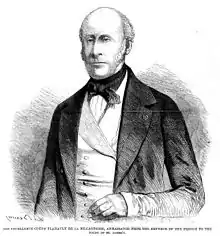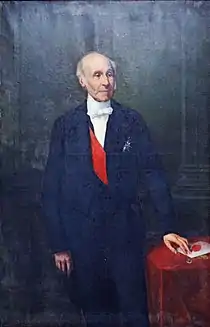Charles Joseph, comte de Flahaut
Auguste-Charles-Joseph de Flahaut de La Billarderie, comte de Flahaut (21 April 1785 – 1 September 1870) was a French general during the Napoleonic Wars, a statesman, and late in life French ambassador to the Court of St James's.[1]
Charles, comte de Flahaut | |
|---|---|
 Charles, de facto 2nd Count of Flahaut | |
| Born | 21 April 1785 Paris, France |
| Died | 1 September 1870 (aged 85) Paris, France |
| Nationality | French |
| Spouse(s) | Margaret, Countess of Flahault, also Baroness Keith and Nairne |
| Issue | |
| Parents | Charles Maurice de Talleyrand-Périgord; Adelaide Filleul, Marchioness of Souza-Botelho |
| www.charles-de-flahaut.fr | |
Biography
.svg.png.webp)
He was born in Paris, officially the son of Marshal Alexandre-Sébastien, comte de Flahaut (2nd son of Charles-César, marquis de La Billarderie) who was guillotined at Arras in February 1793, by his wife, Adélaïde Filleul,[2] However, Charles de Flahaut was generally recognized to be the offspring of his mother's liaison with Talleyrand, with whom he was closely connected throughout his life. His mother took him with her into exile in 1792, and they remained abroad until 1798,[3] moving from England to Switzerland (where she is rumoured to have "become involved" with Louis-Philippe, then Duke of Orleans), before Hamburg where she met her second husband, Ambassador Dom José Maria do Carmo de Sousa Botelho Mourão e Vasconcelos, 5.º Morgado de Mateus.[4][5]
Charles de Flahaut volunteered for military service joining the cavalry in 1800, and received his army commission after the Battle of Marengo. He was appointed aide-de-camp to Joachim, 1st Prince Murat, and was wounded at the Battle of Landbach in 1805.
At Warsaw he met Anne Poniatowska, Countess Potocka with whom he quickly became intimate. After the Battle of Friedland he was awarded the Legion of Honour and returned to Paris in 1807. He served in Spain in 1808, and then in (Germany).[3]

Meanwhile, the Countess Potocka had established herself in Paris, but Flahaut had by this time entered into a relationship with Queen Hortense of Holland; the birth of their son was registered in Paris on 21 October 1811 as Charles-Auguste-Louis-Joseph Demorny, later created Duc de Morny.[3]
Flahaut fought with distinction in the Russian Campaign of 1812 and, in 1813, was appointed Brigadier-General and aide-de-camp to Emperor Napoleon being promoted, after the Battle of Leipzig, as a Général de division. After Napoleon's abdication in 1814 he submitted to the new French government, but was placed on the retired list in September. Flahaut was assiduous in his attendance on Queen Hortense until the Hundred Days brought him back into active service.[3]
A mission to Vienna to secure the return of Empress Marie-Louise resulted in failure. He was present at Waterloo (as an aide-de-camp to Napoleon[6]), and afterwards sought to place Napoleon II on the throne. He was spared exile due to an intervention by Talleyrand, but was placed under police surveillance. Flahaut then chose to leave for Germany, and thence to Britain.[3]
The Flahauts returned to France in 1827 and, in 1830, King Louis-Philippe promoted the Count to the rank of Lieutenant-General as well as creating him a Peer of France. He remained a staunch supporter of Talleyrand's policies, and in 1831 served briefly as French Ambassador to Berlin.[3] Subsequently, he was attached to the household of the Duke of Orléans and, in 1841, was posted as Ambassador to Vienna, where he remained until 1848, when he was dismissed and retired from army service. After the Coup d'état of 1851, his services were re-engaged, and from 1860 to 1862 he served in Britain as French Ambassador to the Court of St James's.

In 1864, the Flahauts returned to Paris and took up residence at the Hôtel de Salm, when Charles was appointed Grand Chancellor of the Legion of Honour.[7] He died in Paris on 1 September 1870.[8]
In the opinion of the unnamed author of a biography on Flahaut in the Encyclopædia Britannica Eleventh Edition: "The comte de Flahaut is perhaps better remembered for his exploits in gallantry, and the elegant manners in which he had been carefully trained by his mother, than for his public services, which were not, however, so inconsiderable as they have sometimes been represented to be".[3]
Family
Flahaut was the lover of Napoleon I's stepdaughter, Hortense de Beauharnais (Queen of Holland), with whom he had an illegitimate son, Charles Demorny (1811–1865) who later became Duke of Morny.[9]
While in Britain Flahaut married in Edinburgh on 20 June 1817 The Hon. Margaret Mercer Elphinstone (1788–1867), daughter of Admiral George, Viscount Keith GCB;[10] she succeeded, in her own right, as 2nd Baroness Keith in 1823 and de jure 7th Lady Nairne in 1837.[11] They had five daughters:
- Emily Jane de Flahaut (16 May 1819 – 25 June 1895),[12] married on 1 November 1843 to Henry, 4th Marquess of Lansdowne KG.
- Clémentine de Flahaut (29 April 1821 – 5 January 1836), died young.
- Georgiana Gabrielle de Flahaut (1822 – 16 July 1907),[3][13] married on 2 February 1871 to Jean Charles Marie Félix, Marquis of La Valette.[14]
- Adélaïde Joséphine Elisabeth de Flahaut (1824 – 3 April 1841), died young.
- Sarah Sophie Louise de Flahaut (1825 – 10 June 1853), died unmarried.
Honours
 Comte de l'Empire
Comte de l'Empire Grand-Croix, Légion d'honneur
Grand-Croix, Légion d'honneur- Grand Cordon of the Order of Leopold.[15]
Notes
- The name Flahaut is sometimes spelled Flahault.
- www.appl-lachaise.net
- Chisholm 1911.
- www.bnf.fr
- www.arqnet.pt
- Siborne 1895, pp. 135.
- Scarisbrick, 2019, p. 297.
- This coincided with the Battle of Sedan that sounded the "death knell of the Second Empire" (Scarisbrick, 2019, p. 302).
- Chisholm 1911b, p. 849.
- www.burkespeerage.com
- Since the then French Ambassador opposed the marriage, Flahaut offered to resign his commission (Chisholm 1911).
- www.nationalarchives.gov.uk
- Lundy 2014, p. 46740 § 467393 cites Mosley 2003, p. 1314
- www.senat.fr
- Almanach royal de Belgique: Classé Et Mis En Ordre Par H. Tarlier /p. 126
Further reading
- Bernardy, Françoise de (Lucy Norton transl.), Son of Talleyrand: The life of Comte Charles de Flahaut, 1785–1870, London (1956) OCLC 565999792
- Chaumont, Jean-Philippe (editor), Archives du général Charles de Flahaut et de sa famille : 565 AP : inventaire, Centre historique des archives nationales, Paris (2005) ISBN 9782110052247 ISBN 9782860003100 OCLC 607725219
- Chisholm, Hugh, ed. (1911b), , Encyclopædia Britannica, 18 (11th ed.), Cambridge University Press, pp. 849–850.
- Lundy, Darryl (1 November 2014), Georgiana Gabrielle de Flahault1, thepeerage.com, p. 46740 § 467393. This work cites Mosley
- Mosley, Charles, ed. (2003), Burke's Peerage, Baronetage & Knightage, 1 (107th in three volumes ed.), Wilmington, Delaware: Burke's Peerage (Genealogical Books), p. 1314
- Scarisbrick, Diana, Margaret de Flahaut (1788–1867): A Scotswoman at the French Court, Cambridge (2019) ISBN 978-1-898565-16-1 OCLC 1076395537
- Siborne, William (1895), The Waterloo Campaign, 1815 (4th ed.), Westminster: A. Constable
Attribution:
 This article incorporates text from a publication now in the public domain: Chisholm, Hugh, ed. (1911), "Flahaut de la Billarderie, Auguste Charles Joseph, Comte de", Encyclopædia Britannica, 10 (11th ed.), Cambridge University Press, p. 468
This article incorporates text from a publication now in the public domain: Chisholm, Hugh, ed. (1911), "Flahaut de la Billarderie, Auguste Charles Joseph, Comte de", Encyclopædia Britannica, 10 (11th ed.), Cambridge University Press, p. 468
External links
- Biographie chez www.charles-de-flahaut.fr (in French)